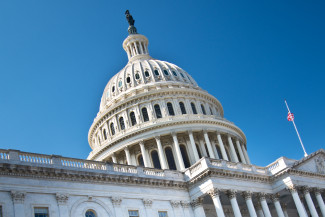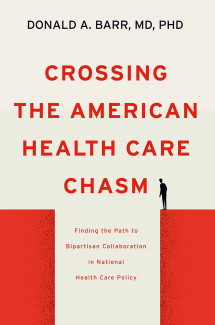
Johns Hopkins UniversityEst. 1876
America’s First Research University
Now Browsing:
Crossing Our Health Care Chasm

By Donald Barr
It is time to build a bridge across the health care chasm that divides our country. Without that bridge, we risk losing access to affordable, quality health care.
This deep divide first began to appear in 2010, following adoption of the Affordable Care Act (ACA). The bipartisanship that was a key part of discussions of health care reform options in the early months of the Obama Administration began to evaporate when the Tea Party initiated its attacks on the reform process in the summer of 2009.
When Republicans took over House leadership after the 2010 elections, it took about two weeks for the House to pass the “Repealing the Job-Killing Health Care Law Act.” Over the next four months, the House passed three similar bills. The Democratic Senate blocked each bill. In October 2013, after nearly 40 attempts to revoke the ACA, House Republicans forced a 16-day government shutdown rather than concede.
In the November 2014 elections, Republicans took control of the Senate and widened their House majority. They jointly approved a bill to revoke funding for core elements of the ACA. President Obama vetoed the legislation.
Failing repeatedly to repeal the ACA in Congress, Republicans and their supporters turned to the courts. They filed a lawsuit to block federal payment of premium tax credits under ACA for eligible individuals and families. While the Supreme Court eventually denied that suit, in November 2014, the House of Representatives filed another lawsuit, this one to block the Obama Administration’s payments to insurance companies to reimburse them for the cost-sharing reductions (CSRs) provided by the ACA.
In May 2016, the federal Court upheld the House’s complaint and blocked federal payment of these subsidies. While the Obama Administration appealed this ruling, the issue became moot when President Trump was elected in November 2016. One of his first acts was to revoke that appeal, and to block federal payment of CSRs. That action had serious adverse impacts on the national market for health insurance. Fortunately, the federal court reinstated CSRs, and they continue to be available to those with incomes below 250 percent of the federal poverty level who select a silver-level plan on the ACA exchanges.

By January of 2019, premiums on the exchanges had once again stabilized. The Republicans were not through, though. They attempted to repeal the ACA by revoking the tax penalty applied to the ACA’s individual mandate to purchase health insurance. A federal judge in Texas ruled that, without that penalty, the mandate was unconstitutional, and since one part of the ACA was unconstitutional the entire ACA is unconstitutional. In June 2021 the Supreme Court overturned that decision as well.
The schism between Republicans and Democrats over what direction our health care system should take has become so wide, it’s hard for those on one side to hear those on the other. It’s as if we are standing on different sides of a deep canyon. How can we possibly build a bridge across that chasm?
I would suggest taking a lesson from the Indigenous peoples of Peru who live on the sides of the Apurimac Canyon, a canyon that is twice as deep as the Grand Canyon. For centuries, these descendants of the Incas have constructed the Queshuachaca Bridge – a bridge across that canyon made of ropes constructed by hand from grass. It takes six of these ropes to construct the bridge. Those on either side of the Canyon collaborate to pull these ropes across the canyon, one at a time. They then weave four of the ropes together into a footbridge, and use the other two ropes as handrails.
If this has worked for the peoples of the Apurimac Canyon, it can also work for the peoples of the ‘Congressional Canyon.’ There are a number of unresolved issues that could act as ropes for the footbridge. Fixing the “family glitch”, reducing drug costs for Medicare, addressing the high cost of health insurance for those over 50, and agreeing to fund the cost sharing reductions are examples. Once these ‘ropes’ have been woven together, establishing ongoing bipartisan planning groups in each house of Congress would act as the handrails, making it easier and safer to cross the bridge.
If the descendants of the Incas in Peru can collaborate to bridge the canyon that divides them, members of Congress can do the same. Now is the time to set partisanship aside and focus collaboratively on building a bridge across the health care chasm.
Order Crossing the American Health Care Chasm: Finding the Path to Bipartisan Collaboration in National Health Care Policy at the following link: https://jhupbooks.press.jhu.edu/title/crossing-american-health-care-chasm
Donald A. Barr, MD, PhD, is a professor of pediatrics and (by courtesy) of education at Stanford University. He is the author of Crossing the American Health Care Chasm: Finding the Path to Bipartisan Collaboration in National Health Care Policy, Introduction to U.S. Health Policy: The Organization, Financing, and Delivery of Health Care in America, and Health Disparities in the United States: Social Class, Race, Ethnicity, and the Social Determinants of Health.

It is time to build a bridge across the health care chasm that divides our country. Without that bridge, we risk losing access to affordable, quality health care.
This deep divide first began to appear in 2010, following adoption of the Affordable Care Act (ACA). The bipartisanship that was a key part of discussions of health care reform options in the early months of the Obama Administration began to evaporate when the Tea Party initiated its attacks on the reform process in the summer of 2009.
When Republicans took over House leadership after the 2010 elections, it took about two weeks for the House to pass the “Repealing the Job-Killing Health Care Law Act.” Over the next four months, the House passed three similar bills. The Democratic Senate blocked each bill. In October 2013, after nearly 40 attempts to revoke the ACA, House Republicans forced a 16-day government shutdown rather than concede.
In the November 2014 elections, Republicans took control of the Senate and widened their House majority. They jointly approved a bill to revoke funding for core elements of the ACA. President Obama vetoed the legislation.
Failing repeatedly to repeal the ACA in Congress, Republicans and their supporters turned to the courts. They filed a lawsuit to block federal payment of premium tax credits under ACA for eligible individuals and families. While the Supreme Court eventually denied that suit, in November 2014, the House of Representatives filed another lawsuit, this one to block the Obama Administration’s payments to insurance companies to reimburse them for the cost-sharing reductions (CSRs) provided by the ACA.
In May 2016, the federal Court upheld the House’s complaint and blocked federal payment of these subsidies. While the Obama Administration appealed this ruling, the issue became moot when President Trump was elected in November 2016. One of his first acts was to revoke that appeal, and to block federal payment of CSRs. That action had serious adverse impacts on the national market for health insurance. Fortunately, the federal court reinstated CSRs, and they continue to be available to those with incomes below 250 percent of the federal poverty level who select a silver-level plan on the ACA exchanges.

By January of 2019, premiums on the exchanges had once again stabilized. The Republicans were not through, though. They attempted to repeal the ACA by revoking the tax penalty applied to the ACA’s individual mandate to purchase health insurance. A federal judge in Texas ruled that, without that penalty, the mandate was unconstitutional, and since one part of the ACA was unconstitutional the entire ACA is unconstitutional. In June 2021 the Supreme Court overturned that decision as well.
The schism between Republicans and Democrats over what direction our health care system should take has become so wide, it’s hard for those on one side to hear those on the other. It’s as if we are standing on different sides of a deep canyon. How can we possibly build a bridge across that chasm?
I would suggest taking a lesson from the Indigenous peoples of Peru who live on the sides of the Apurimac Canyon, a canyon that is twice as deep as the Grand Canyon. For centuries, these descendants of the Incas have constructed the Queshuachaca Bridge – a bridge across that canyon made of ropes constructed by hand from grass. It takes six of these ropes to construct the bridge. Those on either side of the Canyon collaborate to pull these ropes across the canyon, one at a time. They then weave four of the ropes together into a footbridge, and use the other two ropes as handrails.
If this has worked for the peoples of the Apurimac Canyon, it can also work for the peoples of the ‘Congressional Canyon.’ There are a number of unresolved issues that could act as ropes for the footbridge. Fixing the “family glitch”, reducing drug costs for Medicare, addressing the high cost of health insurance for those over 50, and agreeing to fund the cost sharing reductions are examples. Once these ‘ropes’ have been woven together, establishing ongoing bipartisan planning groups in each house of Congress would act as the handrails, making it easier and safer to cross the bridge.
If the descendants of the Incas in Peru can collaborate to bridge the canyon that divides them, members of Congress can do the same. Now is the time to set partisanship aside and focus collaboratively on building a bridge across the health care chasm.
Order Crossing the American Health Care Chasm: Finding the Path to Bipartisan Collaboration in National Health Care Policy at the following link: https://jhupbooks.press.jhu.edu/title/crossing-american-health-care-chasm
Donald A. Barr, MD, PhD, is a professor of pediatrics and (by courtesy) of education at Stanford University. He is the author of Crossing the American Health Care Chasm: Finding the Path to Bipartisan Collaboration in National Health Care Policy, Introduction to U.S. Health Policy: The Organization, Financing, and Delivery of Health Care in America, and Health Disparities in the United States: Social Class, Race, Ethnicity, and the Social Determinants of Health.

Login to View & Leave Comments
Login to View & Leave Comments


